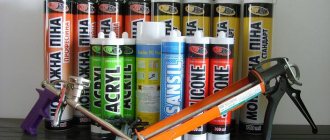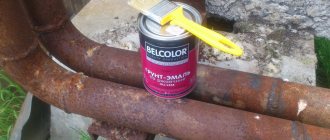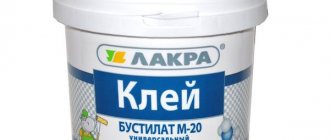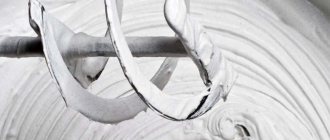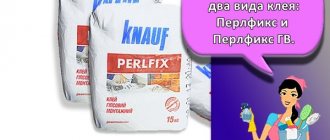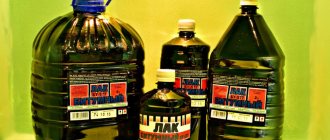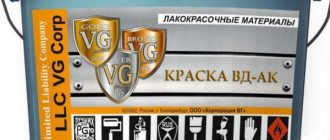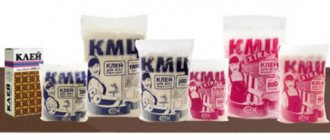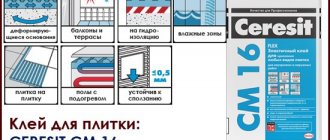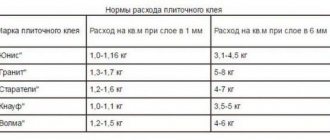Currently, Macroflex 750 is widely used in construction and repair - a sealing sealant, which is a one-component foam (consisting of polyurethane) that hardens in air.
This article describes the characteristics of polyurethane foam, provides technical parameters, and provides recommendations for the correct use of the material.
Polyurethane foam
Advantages and disadvantages
Advantages of using Macroflex foam:
- Foam is a finished product. No preliminary preparation work is required for the work.
- Super-universal foam can be used not only when laying materials, but also for gluing them and sealing seams and cracks.
- Simplicity and ease of use.
- The company's products are characterized by an affordable price.
- Thanks to its composition, the foam provides reliable protection against moisture.
- The hardening of the material occurs faster than the hardening of the cement mixture.
- Macroflex foam can be used with various materials: wood, stone, concrete, metal coatings, PVC, chipboard.
- The temperature range for working with the special assembly mixture varies from -5 to +35 degrees.
- Working with polyurethane foam eliminates the formation of dust and various contaminants, which allows you to reduce the period of cleaning the room after construction procedures.
Flaws:
- Under the influence of ultraviolet rays, foam destruction occurs over time. To protect the material, paint products based on water emulsion, a special sealing material composition, a mixture of cement, and gypsum are used.
- Installation is carried out only with special protective equipment. The mounting tape affects the respiratory organs, skin, and mucous membranes of the eyes.
Advantages and disadvantages
The advantage is that when using adhesive foam, expensive spray installations are not required. The product is easy to apply using an applicator gun. One cylinder replaces up to 25 kg of cement; its contents are used to treat a surface of 12 m².
Reviews from non-professional buyers about the use of Macroflex adhesive foam are positive:
- minimum consumption;
- glues quickly;
- expands little;
- You can glue extruded polystyrene foam;
- Excellent bonding of XPS boards;
- firmly glues penoplex.
See also
Technical characteristics of glue sticks, which one is better and how to make it at home
There is only one drawback - the high price. Advantages confirmed by professional builders:
- there are no cold bridges, thermal insulation is 100%;
- the fixation is strong;
- adhesion is high;
- moisture and mold do not affect the characteristics of the adhesive composition.
Makroflex polyurethane foam: technical characteristics and scope of application
Macroflex is a one-component polyurethane foam in cylinders. Consumption corresponds to the figure declared by the manufacturer. According to customer reviews, this brand of polyurethane foam covers an area twice as large as that of analogues from another manufacturer in a similar 750 ml cylinder. Note that one-component foam hardens when it interacts with moisture. Therefore, air humidity plays a big role here.
Seeing Makroflex products:
- increased yield foam (65);
- professional installation room marked “PRO”;
- fire FR77;
- 2x2 with combination adapter;
- professional winter one marked “Siberian”, which allows you to work at - 18o C;
- a number of products labeled “Premium”;
- foam cement, produced in packages of 850/1000 ml.
Features of Makroflex 750 ml:
- high density – 25-35 kg/m³;
- strength and compression resistance – 3 N/cm²;
- high adhesion to wood, metal, glass, concrete, stone and other common building materials.
Makroflex 750 ml is fireproof, as it contains substances capable of self-extinguishing, and in terms of fire resistance it belongs to class E (according to EN 13501) and B3 (according to DIN 4102).
High adhesion makes the material universal
Primary hardening occurs within 60 minutes, primary expansion - 2 times. Makroflex foam can be used in wide ambient temperature ranges: from -10 to +25 degrees. It can provide heat and sound insulation. Professional Makroflex repels moisture and prevents mold.
Disadvantages include poor tolerance to UV rays. Therefore, upon completion of work, cover the filled joint with putty, sealant or special paint that protects against ultraviolet radiation.
Details
Consumption of Makroflex foam
The composition consumption will depend on the shape and size of the seam. With a rectangular cross-section, the flow rate should be calculated using the following formula - G*W, where G is the depth of the seam in mm and W is the width of the seam in mm. For example, if the depth and width are 6 mm, then the flow rate will be calculated as follows: 6 * 6 = 36 ml. In the case of a triangular seam, the calculation will look like this - 0.5W*D. If the depth and width are 10 cm, then the flow rate will be 50 ml. To ensure maximum foam output, it is worth cutting off the tip of the cartridge at an angle of 45 degrees.
Drying time
The drying parameter depends on many factors - the temperature of the installation mixture, air and environmental humidity, the type and volume of the applied material. At a temperature of +20 degrees, the foam will dry within a couple of hours, but the final hardening will occur only after 12 hours. At a lower temperature, the mixture will dry for a day. During the initial hardening of the mixture, it can be painted, puttyed or cut. The duration of foam hardening can be accelerated by moistening, which also affects adhesion to building materials.
Kinds
The product range from Makroflex contains an extensive list of substances of varying quality and applicability.
- Makroflex Shaketec (Winter) is an all-season foam used in dry and cool conditions (-10°C – +25°C). Provides reliable sound insulation and is capable of completely filling voids when repairing roofs, installing doors and window openings.
- Makroflex Premium based on polyurethane is a type of professional installation products. When used, it increases its volume approximately 2 times. Apply to the surface to be treated using a gun. The high degree of adhesion of the substance allows it to be used when working with wet structures. Sold in cylinders with a capacity of 750 ml.
- Makroflex Premium Mega is a professional-level winter product. Used at a temperature of -15°C, it provides a reliable degree of adhesion to various building materials.
- Makroflex Pro is applied using a special device, the practical yield of material reaches 65 liters. The composition does not contain chloride, fluoride or carbon inclusions and is used for insulating windows and doors and filling various types of voids. How a sealant is used to insulate rooms.
Sealants from Makroflex constitute an independent category of products:
Makroflex TA145 is an ultra-heat-resistant material used in conditions of high temperatures or sudden temperature changes (ovens, ceramic panels of kitchen stoves). The hardening of the TA-145 substance is facilitated by a humid environment. There are no solvents in the composition, the product is odorless and dries within 1-2 days.
Comparative studies indicate that Makroflex sealant has a number of advantages over conventional sealing compounds. In the event of a fire, the material burns without forming cracks into which combustion products can penetrate. The finished coating can withstand from -65°C to +315°C.
Makroflex AX104 is a super-versatile sealant containing silicone, used for self-sealing of building elements during work in indoor and outdoor environments. Has excellent adhesion to materials made of glass, ceramics and aluminum. The product contains antifungal components.
The substrate is resistant to ultraviolet radiation. Favorable temperature for installation is +5°С – +40°С in the absence of moisture. Can be stored for up to 18 months.
- Makroflex NX108. It is characterized by high adhesion to wood, glass, metal, ceramic, plastic, and concrete surfaces. The product is resistant to rust and ultraviolet radiation. The advantage of the substrate is that it can be used in conditions of high humidity (for example, in a bathroom).
- Makroflex FA131 is an effective frost-resistant polyacrylic product. Used for processing suture elements and structural defects, interior and exterior work. The material is resistant to sudden temperature changes. It is not recommended to use it in conditions of high humidity. The main functionality is the processing of seam elements and defects in concrete, brick, wood and other types of coatings.
- Makroflex SX101. Performs sanitary functions because it contains antifungal fungicides. Used in conditions of high humidity. The substance is white or colorless.
It should not be used to treat aquariums as the substrate contains antiseptics. Upon contact with the stone, stains may appear. Application is limited to temperature conditions – +5°С – +40°С.
Makroflex MFf190 is a powerful, extra-strong white adhesive substrate based on an aqueous dispersion of polymers. Used in the process of gluing plastic and wood products for internal and external work. It works quickly and efficiently.
There is a certain classification that divides foam into products for household and professional purposes. When sealing small cracks or installing small products, it is irrational to purchase professional foam. In addition, household grade foam increases in volume to a greater extent than professional grade foam.
It is important to know that the shrinkage of professional foam is small (within 0-3%), for household foam this parameter is up to 5%. Shrinkage should not exceed 5%, since such an excess leads to deformation of the substance, and sometimes to unwanted ruptures
Based on this, professional foam Makroflex 750 ml is used in more critical cases, for example:
- thermal insulation of heating networks, roofs;
- filling various voids;
- construction of insulating bulkheads;
- construction of fire-resistant structures (fire-resistant Makroflex FR77).
Choosing the right polyurethane foam
To avoid mistakes and rework when carrying out repair and installation work, choose the right polyurethane foam. First, decide on the objectives of using the sealant. What are you planning to foam? Where will the work be carried out - outdoors or indoors? At what temperature? Calculate the approximate volume of required material based on the technical specifications. Think about what kind of cleaner to prepare.
Strengthening the window frame
Requirements for Macroflex, as well as for other types of polyurethane foam (for example, Soudal), include the following technical conditions and properties:
- Fire-resistant packaging and sale in the form of aerosols;
- When applied to the surface, polymerization and hardening must occur within the time period indicated on the packaging;
- Required level of adhesion (adhesion) to ensure installation work;
- When drying, the foam should be elastic, not crumble or collapse;
- The secondary expansion coefficient must correspond to that indicated in the certificate and on the packaging.
Varieties
Polyurethane foam Macroflex 750 is available in professional and semi-professional versions. The difference lies in the characteristics, configuration and packaging.
Professional Macroflex foam has a reduced coefficient of secondary expansion, and the container is equipped with a mount for a specialized gun and holds 750 ml of material.
Semi-professional packaging is equipped with a tube that facilitates the release of sealant. If you take a break from working with semi-professional foam for more than 30 minutes, you will have to clean the nozzle, which will require a cleaner.
Types of foam are also classified according to the seasonal purpose of Macroflex. Summer, winter and universal (all-season) foam is produced. The first is used at temperatures above +5 degrees. Winter involves use down to -18.
The technical characteristics of these three types of foam sealant are different. The winter type of sealant is suitable for work at low temperatures, but at the same time the expansion coefficient and material consumption are reduced. Winter Macroflex can be applied to damp materials covered with frost.
The difference between universal foam is the high consumption of sealant, accelerated polymerization and hardening. They also work with the universal Macroflex at sub-zero temperatures - about ten degrees, without warming up the can. But do not forget that in the winter season the material takes longer to harden.
Spray can attachment - pistol
Makroflex: household or professional
There is an opinion that beginners should use household foam in their work. This is partly true. For work such as sealing small cracks and installing small products, household foam is used. It makes no sense to buy a professional one for this type of work. As for professional foam, it is applied to the surface using a gun, which allows you to more accurately dose the volume and control the consumption of the substance.
The main difference between household and professional foam is shrinkageHousehold foam doubles in volume. As for the secondary professional expansion, it is practically absent. The shrinkage coefficient of professional foam is minimal: from 0 to 3%, which cannot be said about household foam, where the indicated figures are 5-7%. Household ones are used once, professional ones – repeatedly.
Professional foam Makroflex 750 ml is used for:
- thermal insulation of roofs, heating networks or walls;
- filling cavities;
- creating partitions with soundproofing properties;
- in fire-resistant structures, as fire protection (Makroflex FR77 fire-resistant).
It should be remembered that the substance hardens in about 24 hours. Because of this, large voids cannot be filled at one time. Use several balls.
Specifications
The official manufacturer declares the following technical parameters of Makroflex products, which in the vast majority of cases is true:
- The final hardening time of the substance used is exactly one day. At temperatures above +20°C, the hardening time is reduced to 1.5-2 hours.
- Thermal stability of the product is from -50°С to +100°С.
- The density of the hardened substance is 25-35 kg/m3.
- The ignition temperature of foam is about 400°C.
- The degree of fire resistance of the hardened product is from B1 (fire-resistant) to B3 (flammable).
- Foam yield is from 25 to 50 liters, depending on the volume of packaging. With similar characteristics, Makroflex brand products provide a substance yield that is approximately 10% higher than that of analogues of other brands.
Reliable level of strength – up to 3 N/cm² in compression and tension. The shelf life of the product in the package is up to 15 months (it is better to store the tube vertically to maintain tightness). Storage temperature – not lower than +5°С. Storing the product directly under solar radiation is strictly prohibited. The productivity of foam application is limited by ambient temperature. The product exhibits its best qualities at a temperature not lower than +5°C. A special composition has been developed and sold for use in winter
However, it is important to know that at low temperatures the foam takes longer to harden, and accordingly, its filling properties decrease.
Purpose of Macroflex foam
Polyurethane sealant, which can also be called polyurethane foam, is available in cylinders of various capacities. The components of the sealant are a prepolymer and a displacing gas (propellant). When the prepolymer leaves the container, it hardens as a result of interaction with air. The result of hardening is the formation of fairly rigid polyurethane foam, which penetrates into cracks, recesses, and holes. This explains the purpose of Macroflex foam:
- Sealing joints, cracks, holes.
- Filling voids in the material.
- Gluing together several materials.
- Thermal insulation and sound insulation of various surfaces and premises.
There are several types of Macroflex foam. Foam for household use has an attached plastic tube through which it exits the container. The professional version has a special outlet for attaching a mounting gun. In addition, professional foam has a higher yield of the finished composition, and it costs more.
Properties of Macroflex foam
The following properties and features of Macroflex foam 750 ml can be highlighted:
- Excellent adhesion to any hard materials. The liquid composition interacts best with concrete, brick, wooden surfaces, glass, plastic, metal, and cellular concrete.
- To obtain the most reliable connection, it is advisable to remove dust from the working surface. For example, wet it. However, the presence of ice or frost on the surface will negatively affect the quality of the connection.
- Any atmospheric influences cannot harm the hardened Macroflex foam. Only UV radiation has a negative effect on it, under the influence of which the polyurethane foam gradually breaks down and begins to crumble. This is a mandatory condition that must be observed when installing external structures. Frozen seams must be covered with some material. These can be metal, wood, plastic trim or corners, as well as plaster, cement mortar or paint.
- It is recommended to use Macroflex for filling cracks of at least 0.5 cm and no more than 8 cm. In cracks that are too narrow, the composition may not penetrate to the required depth, and the walls of cracks that are too wide will not be able to hold a heavy viscous mass.
- Liquid, just applied foam has a slight smell of polyurethane. After hardening there are no odors.
- The frozen mass is sensitive to high humidity. Water absorption of Macroflex 750 ml is 10%. That is, when left in water for a long time, the material becomes saturated with water, which gradually penetrates the cells and destroys them.
- Cured Macroflex foam is not toxic or harmful to humans. There are no foreign secretions from its surface.
Where is it used?
The scope of application of Macroflex foam cement is really wide. With her help:
- fill small seams and joints, such as when installing windows and doorways;
- install window sills and steps;
- attach decorative panels to walls, ceilings, insulating panels to facades and foundations;
- fix individual parts;
- They fasten gas silicate and foam blocks together when you need to build a wall or partition.
Thus, Makroflex foam cement is used as a mounting foam and as a cement mortar for laying. Many people are skeptical about the latter. Like, foam is something frivolous, and this whole structure will fall apart in a year. But we are not talking about ordinary polyurethane foam. Foam cement, of course, is also suitable for installing window profiles, but that is not what it was developed for.
The tensile strength of different materials joining each other was tested in laboratory conditions.
- The adhesion of granite to cement and foam-cement to wood are comparable in strength (2 MPa).
- The connection of PVC with this foam is not much worse - in strength it corresponds to the connection of concrete with cement (1 MPa).
- And finally, with concrete, as well as with glass and ceramics, the adhesion was estimated at 0.3 MPa. Note that these are not porous materials, so you can be sure that Macroflex foam will adhere more reliably to foam concrete.
- Next come bitumen coatings and foam plastic (0.2 MPa). In terms of strength, it is about the same as tile adhesive with tiles (that is, it is still quite reliable).
- The last surfaces on the list are galvanized, plasterboard and mineral wool (0.1 MPa). In the absence of load, such a connection will hold normally.
- It is not recommended to apply Makroflex foam cement to Teflon, polyethylene, greasy and icy surfaces.
How to use polyurethane foam
These are the facts. But it is also true that the product is relatively new, so there is little data on how it will behave in 30-50 years. What reactions occur inside it, what properties it will show in real conditions under temperature changes, under the influence of microorganisms, moisture, and chemicals is unknown.
There is a compromise option that will suit everyone: use polyurethane foam for internal partitions, and cement mixture for load-bearing walls.
And one more thing: not everyone knows how wide the gap is permissible to foam. There is no point in doing this:
- for a seam less than 3 cm - it should be sealed with a sealant (based on silicone or acrylic);
- for a seam larger than 10 cm, additional inserts are needed here (block, sandwich panel, brick).
Additional tips and tricks
The optimal temperature of the working mass inside the cylinder is 23 °C. To achieve this, it is recommended to keep it at 22-25 °C for about 12 hours before starting work. Use the product as follows:
- shake the bottle 20 times;
- remove the protective cover;
- attach the gun.
During these operations, keep the cylinder upside down. When doing the main work (applying glue), hold it with the bottom up. The speed of foam release can be adjusted using standard methods using a screw on the gun and a trigger. Shake the can regularly during use.
To prevent the foam from hardening, adhere to the following rules for operating the gun:
- do not remove it while there is foam in the container;
- when the glue runs out, quickly disconnect the empty container, replacing it with a new one;
- After completing the work, clean the device with a special liquid (Premium Cleaner);
- Remove the hardened mass mechanically.
It is recommended to store cylinders with glue for no more than 15 months, maintaining a storage temperature of 5-25 °C. At the same time, place them strictly vertically, the valve should look up. When transporting, wrap the product in cloth. Transport in the trunk. Observe safety precautions when working. Do not smoke or light a fire near. It is necessary to ensure a flow of fresh air in the room. Protect the skin of your hands with gloves and your eyes with goggles. Do not inhale vapors.
Instructions for use
Before working with foam, study the instructions for use. To treat surfaces, follow the manufacturer's recommendations:
- Clean surfaces from dirt and other foreign substances;
- Cover areas that are not being treated with film;
- Before spraying, the can is kept at room temperature for 12 hours;
- Shake the can thoroughly, then remove the cap and put on the gun or tube;
Spray the composition while holding the container in a vertical position with the bottom up. Subsequent expandability of the composition should be taken into account. When several layers are applied, they are moistened with water. Shake the can periodically during use. If the humidity is too high, you will have to apply 3-4 layers.
In the video you can see Macroflex Cement:
Technical characteristics Macroflex 750 ml
We list the characteristics corresponding to the Makroflex 750 ml polyurethane foam:
- The use of Macroflex is limited by temperature conditions. It is recommended to use foam if the air temperature is at least +5 degrees. You can use a special composition for winter work, but you need to take into account that at low temperatures Macroflex hardens for a long time and fills a smaller volume.
- The maximum time for complete hardening of the applied composition is 24 hours. At temperatures above +20 degrees, the hardening time can be reduced to 1.5 hours.
- Thermal resistance of the foam is 55 +100 degrees.
- The density of the hardened composition is 25-35 kg/cubic meter.
- The combustion temperature of Macroflex is 400 degrees.
- The fire resistance of hardened polyurethane foam is B3 (according to DIN 4102).
- Foam yield is 20-50 liters, depending on the weight of the contents. It is estimated that, with equal characteristics, Makroflex products can provide a foam yield of 10% more than similar products from other companies.
- Tensile and compressive strength - 3 N/cm².
- The shelf life in the cylinder is no more than 15 months. It is recommended to store the foam only in an upright position to avoid the container losing its seal. Storage temperature is at least +5 degrees. Do not store cylinders in direct sunlight.
Recommendations for using Macroflex
The application procedure is simple - when the valve is opened, the liquid substance of polyurethane foam is released out under the pressure of the gas in the can and gradually hardens, interacting with water in the atmosphere. Hardening of the material lasts a day. In this case, the foam expands in volume from 50% to 250%.
Non-frost-resistant foam is used at temperatures above +5°C. At low temperatures close to zero, the can is kept at room temperature for at least 12 hours before use. Before starting work, shake the container. To apply Macroflex to the surface, the can is held bottom up, both in the case of manual application of foam and using a mounting gun.
Before foaming, the surface must be cleaned of dust and slightly moistened. Moistening the surface will increase the adhesion of the foam and speed up hardening. The amount of foam applied is adjusted by changing the angle of the outlet valve. After filling with Macroflex, you need to immediately clean off uncured stains using a special cleaner. Otherwise, frozen pieces of foam will have to be peeled off the surface with great difficulty.
Roof insulation from the inside
Main characteristics of Macroflex 750
Macroflex polyurethane foam has a one-component structure. It hardens quickly and has excellent adhesion (sticking, adhesion) to wood, metal and concrete surfaces. Macroflex has good heat and sound insulation, moisture resistance and durability.
Macroflex is used for installation and repair of window openings, door frames, for sealing cavities, seams, joints and cracks. It is used in the construction of screens for sound insulation and thermal insulation, helps in the installation of building parts and seals connections.
When extruded from a 750 ml can in which foam is stored and sold, the material expands, reaching 100% of the original volume and gradually hardens. This achieves sealing of joints, cavities and cavities when installing door and window openings. By doubling in size during hardening, the foam can deform structures if they are made of soft material. Take this nuance into account while working.
Another important characteristic of foam is that this material does not tolerate solar radiation, so it is necessary to protect the filled areas to avoid destruction of the sealant.
The material is also suitable for harsh weather conditions.
Soudal
Special mention should be made of super-frost-resistant foam. Which successfully promotes its product to the Russian market, since such sealant is in demand in cold conditions. The unique characteristics of “Soudal”, with the help of which construction and installation works are carried out, replacement of windows and doors at temperatures down to minus 25 ° C.
This material is durable, resistant to stretching and compression. The adhesive properties of foam to basic materials (stone, metal, concrete and wood) even at extremely low temperatures meet European requirements. This type of sealant is fire-resistant, and in terms of other characteristics Soudal twice exceeds the requirements for similar materials that exist today.
